Managerial Economics: Wage Discrimination Report, Semester 1, 2019
VerifiedAdded on 2023/01/23
|7
|2581
|84
Report
AI Summary
This report provides a comprehensive analysis of wage discrimination, exploring its definition, measurement techniques, and the various theories that attempt to explain its existence. The report delves into the concept of wage discrimination, highlighting how it occurs when workers performing similar tasks receive different wages based on factors such as race, gender, and ethnicity. It examines the challenges in accurately measuring wage discrimination, and discusses the Human Capital Theory and Labor Market Discrimination theories. The report also examines the impact of discrimination, and the role of policies, such as the Equal Pay Act and the Civil Rights Act, in addressing the issue, and provides insights into the legal and economic implications of wage disparities in the workplace. The report underscores the importance of understanding and addressing wage discrimination to promote fairness and equality in the labor market.
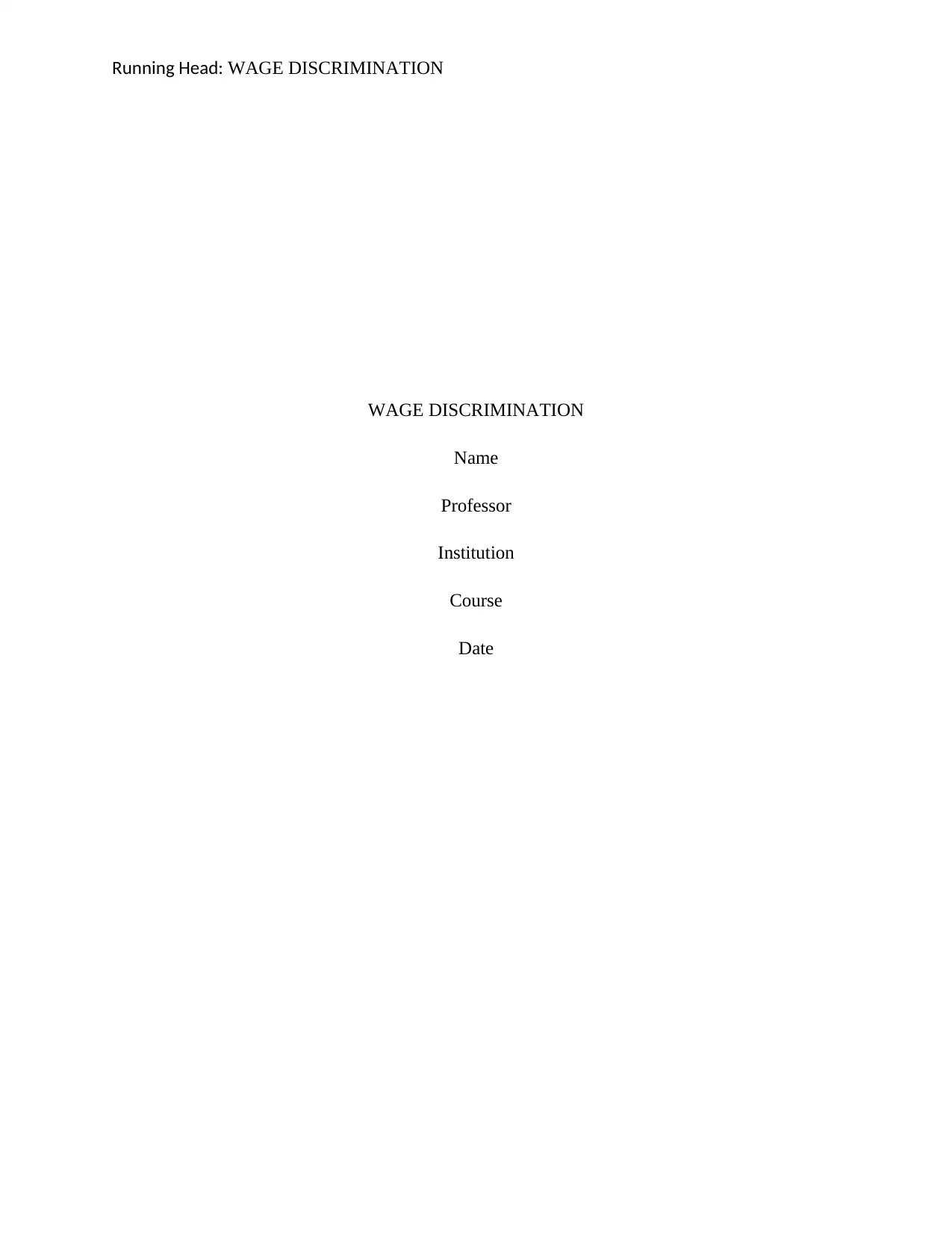
Running Head: WAGE DISCRIMINATION
WAGE DISCRIMINATION
Name
Professor
Institution
Course
Date
WAGE DISCRIMINATION
Name
Professor
Institution
Course
Date
Paraphrase This Document
Need a fresh take? Get an instant paraphrase of this document with our AI Paraphraser
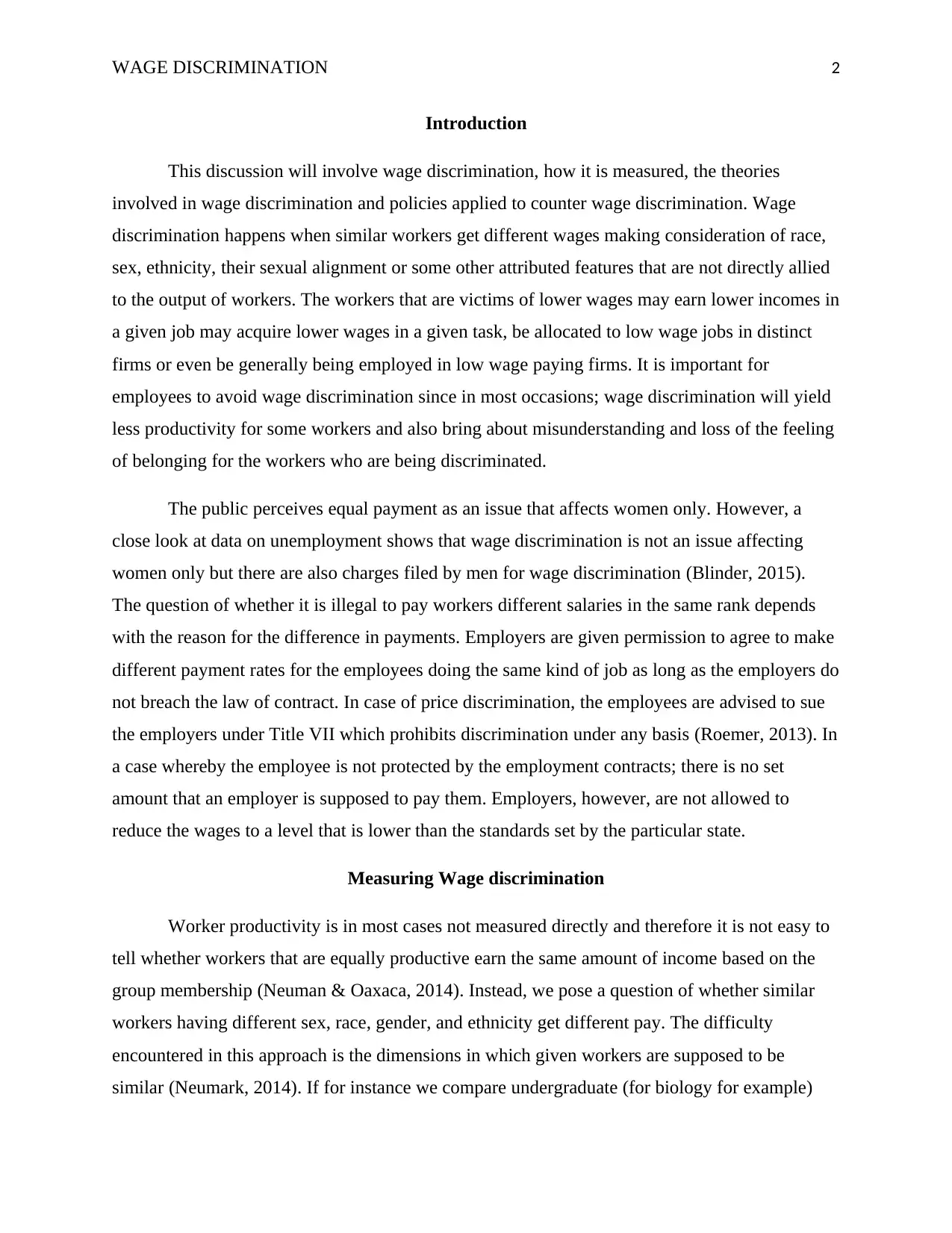
WAGE DISCRIMINATION 2
Introduction
This discussion will involve wage discrimination, how it is measured, the theories
involved in wage discrimination and policies applied to counter wage discrimination. Wage
discrimination happens when similar workers get different wages making consideration of race,
sex, ethnicity, their sexual alignment or some other attributed features that are not directly allied
to the output of workers. The workers that are victims of lower wages may earn lower incomes in
a given job may acquire lower wages in a given task, be allocated to low wage jobs in distinct
firms or even be generally being employed in low wage paying firms. It is important for
employees to avoid wage discrimination since in most occasions; wage discrimination will yield
less productivity for some workers and also bring about misunderstanding and loss of the feeling
of belonging for the workers who are being discriminated.
The public perceives equal payment as an issue that affects women only. However, a
close look at data on unemployment shows that wage discrimination is not an issue affecting
women only but there are also charges filed by men for wage discrimination (Blinder, 2015).
The question of whether it is illegal to pay workers different salaries in the same rank depends
with the reason for the difference in payments. Employers are given permission to agree to make
different payment rates for the employees doing the same kind of job as long as the employers do
not breach the law of contract. In case of price discrimination, the employees are advised to sue
the employers under Title VII which prohibits discrimination under any basis (Roemer, 2013). In
a case whereby the employee is not protected by the employment contracts; there is no set
amount that an employer is supposed to pay them. Employers, however, are not allowed to
reduce the wages to a level that is lower than the standards set by the particular state.
Measuring Wage discrimination
Worker productivity is in most cases not measured directly and therefore it is not easy to
tell whether workers that are equally productive earn the same amount of income based on the
group membership (Neuman & Oaxaca, 2014). Instead, we pose a question of whether similar
workers having different sex, race, gender, and ethnicity get different pay. The difficulty
encountered in this approach is the dimensions in which given workers are supposed to be
similar (Neumark, 2014). If for instance we compare undergraduate (for biology for example)
Introduction
This discussion will involve wage discrimination, how it is measured, the theories
involved in wage discrimination and policies applied to counter wage discrimination. Wage
discrimination happens when similar workers get different wages making consideration of race,
sex, ethnicity, their sexual alignment or some other attributed features that are not directly allied
to the output of workers. The workers that are victims of lower wages may earn lower incomes in
a given job may acquire lower wages in a given task, be allocated to low wage jobs in distinct
firms or even be generally being employed in low wage paying firms. It is important for
employees to avoid wage discrimination since in most occasions; wage discrimination will yield
less productivity for some workers and also bring about misunderstanding and loss of the feeling
of belonging for the workers who are being discriminated.
The public perceives equal payment as an issue that affects women only. However, a
close look at data on unemployment shows that wage discrimination is not an issue affecting
women only but there are also charges filed by men for wage discrimination (Blinder, 2015).
The question of whether it is illegal to pay workers different salaries in the same rank depends
with the reason for the difference in payments. Employers are given permission to agree to make
different payment rates for the employees doing the same kind of job as long as the employers do
not breach the law of contract. In case of price discrimination, the employees are advised to sue
the employers under Title VII which prohibits discrimination under any basis (Roemer, 2013). In
a case whereby the employee is not protected by the employment contracts; there is no set
amount that an employer is supposed to pay them. Employers, however, are not allowed to
reduce the wages to a level that is lower than the standards set by the particular state.
Measuring Wage discrimination
Worker productivity is in most cases not measured directly and therefore it is not easy to
tell whether workers that are equally productive earn the same amount of income based on the
group membership (Neuman & Oaxaca, 2014). Instead, we pose a question of whether similar
workers having different sex, race, gender, and ethnicity get different pay. The difficulty
encountered in this approach is the dimensions in which given workers are supposed to be
similar (Neumark, 2014). If for instance we compare undergraduate (for biology for example)
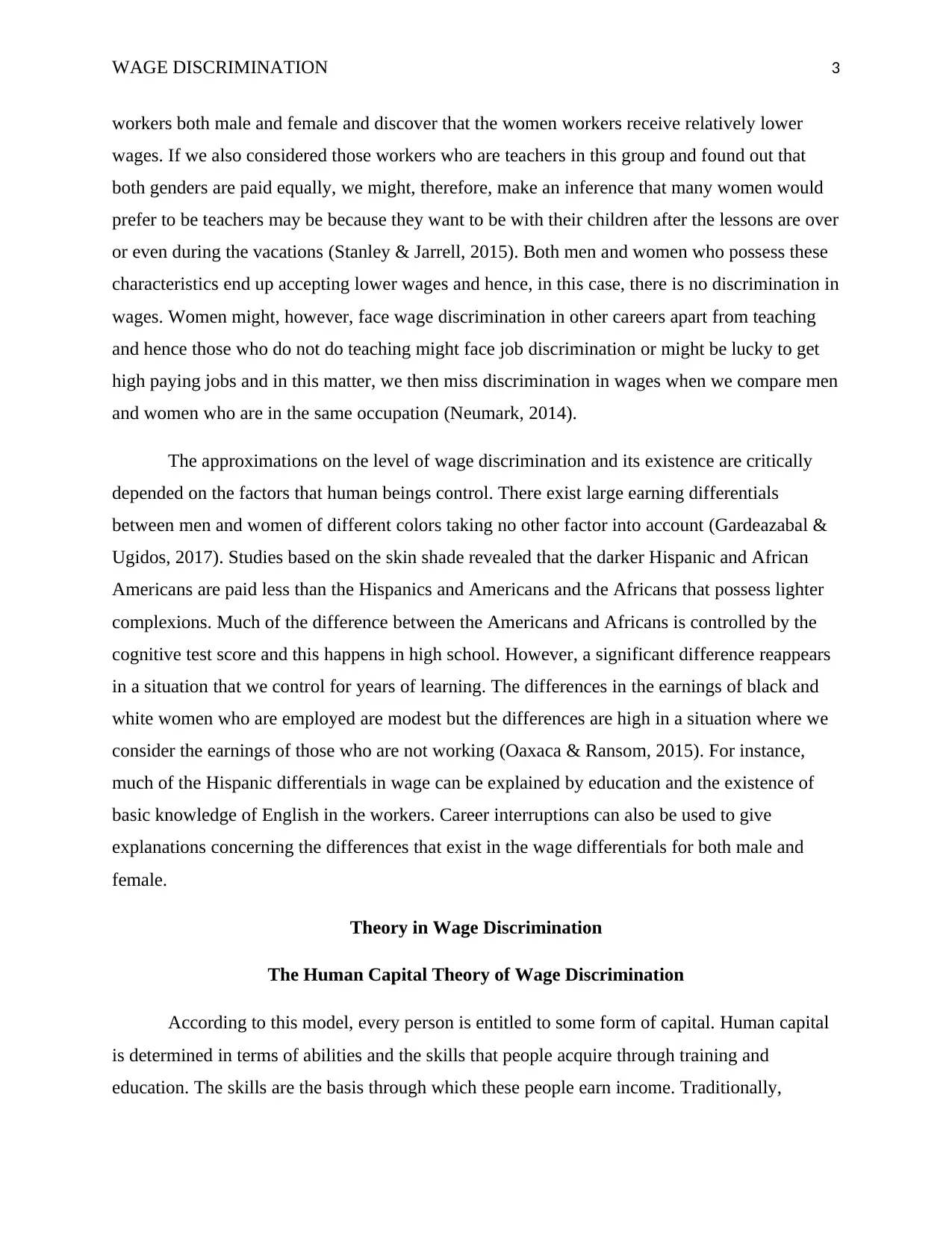
WAGE DISCRIMINATION 3
workers both male and female and discover that the women workers receive relatively lower
wages. If we also considered those workers who are teachers in this group and found out that
both genders are paid equally, we might, therefore, make an inference that many women would
prefer to be teachers may be because they want to be with their children after the lessons are over
or even during the vacations (Stanley & Jarrell, 2015). Both men and women who possess these
characteristics end up accepting lower wages and hence, in this case, there is no discrimination in
wages. Women might, however, face wage discrimination in other careers apart from teaching
and hence those who do not do teaching might face job discrimination or might be lucky to get
high paying jobs and in this matter, we then miss discrimination in wages when we compare men
and women who are in the same occupation (Neumark, 2014).
The approximations on the level of wage discrimination and its existence are critically
depended on the factors that human beings control. There exist large earning differentials
between men and women of different colors taking no other factor into account (Gardeazabal &
Ugidos, 2017). Studies based on the skin shade revealed that the darker Hispanic and African
Americans are paid less than the Hispanics and Americans and the Africans that possess lighter
complexions. Much of the difference between the Americans and Africans is controlled by the
cognitive test score and this happens in high school. However, a significant difference reappears
in a situation that we control for years of learning. The differences in the earnings of black and
white women who are employed are modest but the differences are high in a situation where we
consider the earnings of those who are not working (Oaxaca & Ransom, 2015). For instance,
much of the Hispanic differentials in wage can be explained by education and the existence of
basic knowledge of English in the workers. Career interruptions can also be used to give
explanations concerning the differences that exist in the wage differentials for both male and
female.
Theory in Wage Discrimination
The Human Capital Theory of Wage Discrimination
According to this model, every person is entitled to some form of capital. Human capital
is determined in terms of abilities and the skills that people acquire through training and
education. The skills are the basis through which these people earn income. Traditionally,
workers both male and female and discover that the women workers receive relatively lower
wages. If we also considered those workers who are teachers in this group and found out that
both genders are paid equally, we might, therefore, make an inference that many women would
prefer to be teachers may be because they want to be with their children after the lessons are over
or even during the vacations (Stanley & Jarrell, 2015). Both men and women who possess these
characteristics end up accepting lower wages and hence, in this case, there is no discrimination in
wages. Women might, however, face wage discrimination in other careers apart from teaching
and hence those who do not do teaching might face job discrimination or might be lucky to get
high paying jobs and in this matter, we then miss discrimination in wages when we compare men
and women who are in the same occupation (Neumark, 2014).
The approximations on the level of wage discrimination and its existence are critically
depended on the factors that human beings control. There exist large earning differentials
between men and women of different colors taking no other factor into account (Gardeazabal &
Ugidos, 2017). Studies based on the skin shade revealed that the darker Hispanic and African
Americans are paid less than the Hispanics and Americans and the Africans that possess lighter
complexions. Much of the difference between the Americans and Africans is controlled by the
cognitive test score and this happens in high school. However, a significant difference reappears
in a situation that we control for years of learning. The differences in the earnings of black and
white women who are employed are modest but the differences are high in a situation where we
consider the earnings of those who are not working (Oaxaca & Ransom, 2015). For instance,
much of the Hispanic differentials in wage can be explained by education and the existence of
basic knowledge of English in the workers. Career interruptions can also be used to give
explanations concerning the differences that exist in the wage differentials for both male and
female.
Theory in Wage Discrimination
The Human Capital Theory of Wage Discrimination
According to this model, every person is entitled to some form of capital. Human capital
is determined in terms of abilities and the skills that people acquire through training and
education. The skills are the basis through which these people earn income. Traditionally,
⊘ This is a preview!⊘
Do you want full access?
Subscribe today to unlock all pages.

Trusted by 1+ million students worldwide
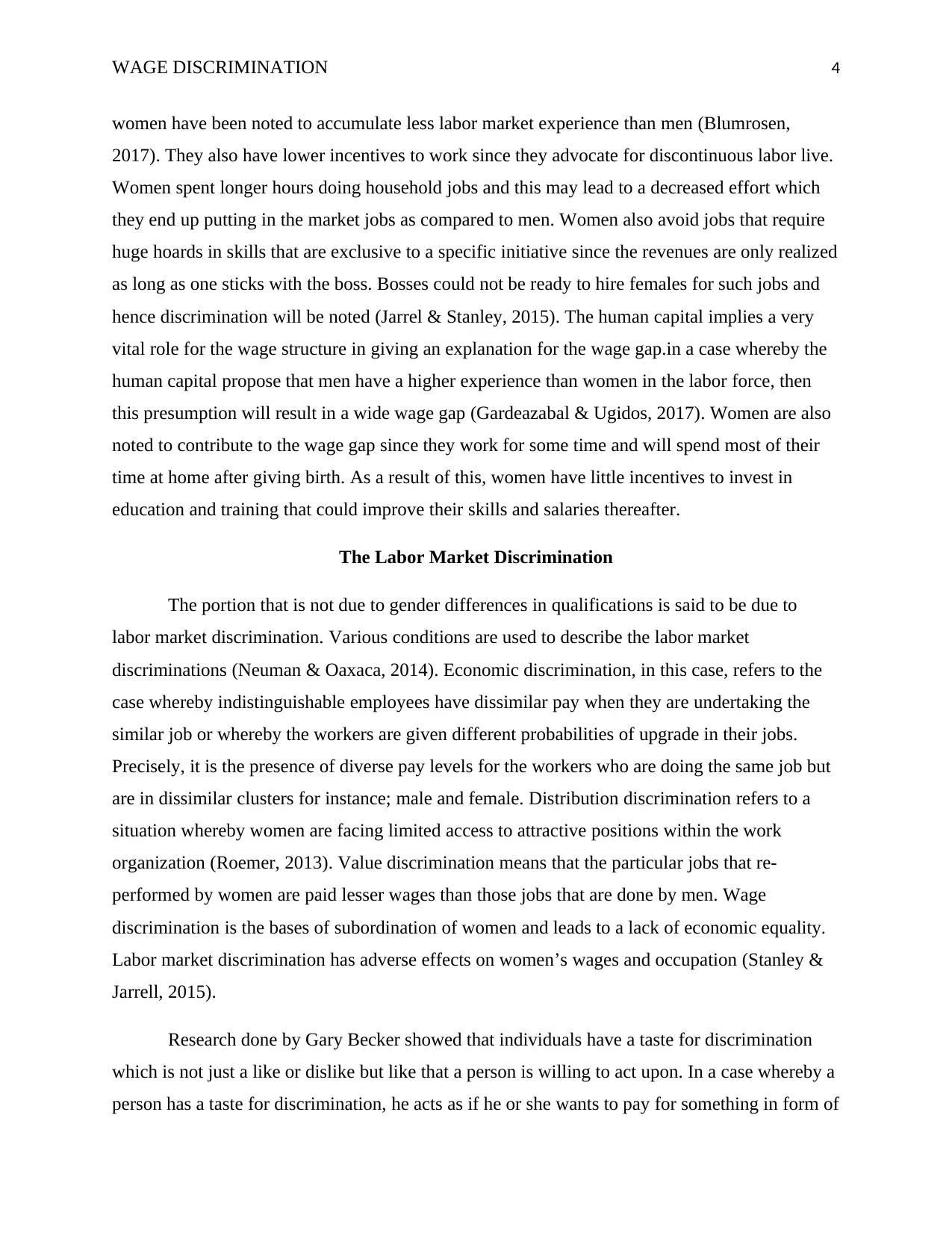
WAGE DISCRIMINATION 4
women have been noted to accumulate less labor market experience than men (Blumrosen,
2017). They also have lower incentives to work since they advocate for discontinuous labor live.
Women spent longer hours doing household jobs and this may lead to a decreased effort which
they end up putting in the market jobs as compared to men. Women also avoid jobs that require
huge hoards in skills that are exclusive to a specific initiative since the revenues are only realized
as long as one sticks with the boss. Bosses could not be ready to hire females for such jobs and
hence discrimination will be noted (Jarrel & Stanley, 2015). The human capital implies a very
vital role for the wage structure in giving an explanation for the wage gap.in a case whereby the
human capital propose that men have a higher experience than women in the labor force, then
this presumption will result in a wide wage gap (Gardeazabal & Ugidos, 2017). Women are also
noted to contribute to the wage gap since they work for some time and will spend most of their
time at home after giving birth. As a result of this, women have little incentives to invest in
education and training that could improve their skills and salaries thereafter.
The Labor Market Discrimination
The portion that is not due to gender differences in qualifications is said to be due to
labor market discrimination. Various conditions are used to describe the labor market
discriminations (Neuman & Oaxaca, 2014). Economic discrimination, in this case, refers to the
case whereby indistinguishable employees have dissimilar pay when they are undertaking the
similar job or whereby the workers are given different probabilities of upgrade in their jobs.
Precisely, it is the presence of diverse pay levels for the workers who are doing the same job but
are in dissimilar clusters for instance; male and female. Distribution discrimination refers to a
situation whereby women are facing limited access to attractive positions within the work
organization (Roemer, 2013). Value discrimination means that the particular jobs that re-
performed by women are paid lesser wages than those jobs that are done by men. Wage
discrimination is the bases of subordination of women and leads to a lack of economic equality.
Labor market discrimination has adverse effects on women’s wages and occupation (Stanley &
Jarrell, 2015).
Research done by Gary Becker showed that individuals have a taste for discrimination
which is not just a like or dislike but like that a person is willing to act upon. In a case whereby a
person has a taste for discrimination, he acts as if he or she wants to pay for something in form of
women have been noted to accumulate less labor market experience than men (Blumrosen,
2017). They also have lower incentives to work since they advocate for discontinuous labor live.
Women spent longer hours doing household jobs and this may lead to a decreased effort which
they end up putting in the market jobs as compared to men. Women also avoid jobs that require
huge hoards in skills that are exclusive to a specific initiative since the revenues are only realized
as long as one sticks with the boss. Bosses could not be ready to hire females for such jobs and
hence discrimination will be noted (Jarrel & Stanley, 2015). The human capital implies a very
vital role for the wage structure in giving an explanation for the wage gap.in a case whereby the
human capital propose that men have a higher experience than women in the labor force, then
this presumption will result in a wide wage gap (Gardeazabal & Ugidos, 2017). Women are also
noted to contribute to the wage gap since they work for some time and will spend most of their
time at home after giving birth. As a result of this, women have little incentives to invest in
education and training that could improve their skills and salaries thereafter.
The Labor Market Discrimination
The portion that is not due to gender differences in qualifications is said to be due to
labor market discrimination. Various conditions are used to describe the labor market
discriminations (Neuman & Oaxaca, 2014). Economic discrimination, in this case, refers to the
case whereby indistinguishable employees have dissimilar pay when they are undertaking the
similar job or whereby the workers are given different probabilities of upgrade in their jobs.
Precisely, it is the presence of diverse pay levels for the workers who are doing the same job but
are in dissimilar clusters for instance; male and female. Distribution discrimination refers to a
situation whereby women are facing limited access to attractive positions within the work
organization (Roemer, 2013). Value discrimination means that the particular jobs that re-
performed by women are paid lesser wages than those jobs that are done by men. Wage
discrimination is the bases of subordination of women and leads to a lack of economic equality.
Labor market discrimination has adverse effects on women’s wages and occupation (Stanley &
Jarrell, 2015).
Research done by Gary Becker showed that individuals have a taste for discrimination
which is not just a like or dislike but like that a person is willing to act upon. In a case whereby a
person has a taste for discrimination, he acts as if he or she wants to pay for something in form of
Paraphrase This Document
Need a fresh take? Get an instant paraphrase of this document with our AI Paraphraser
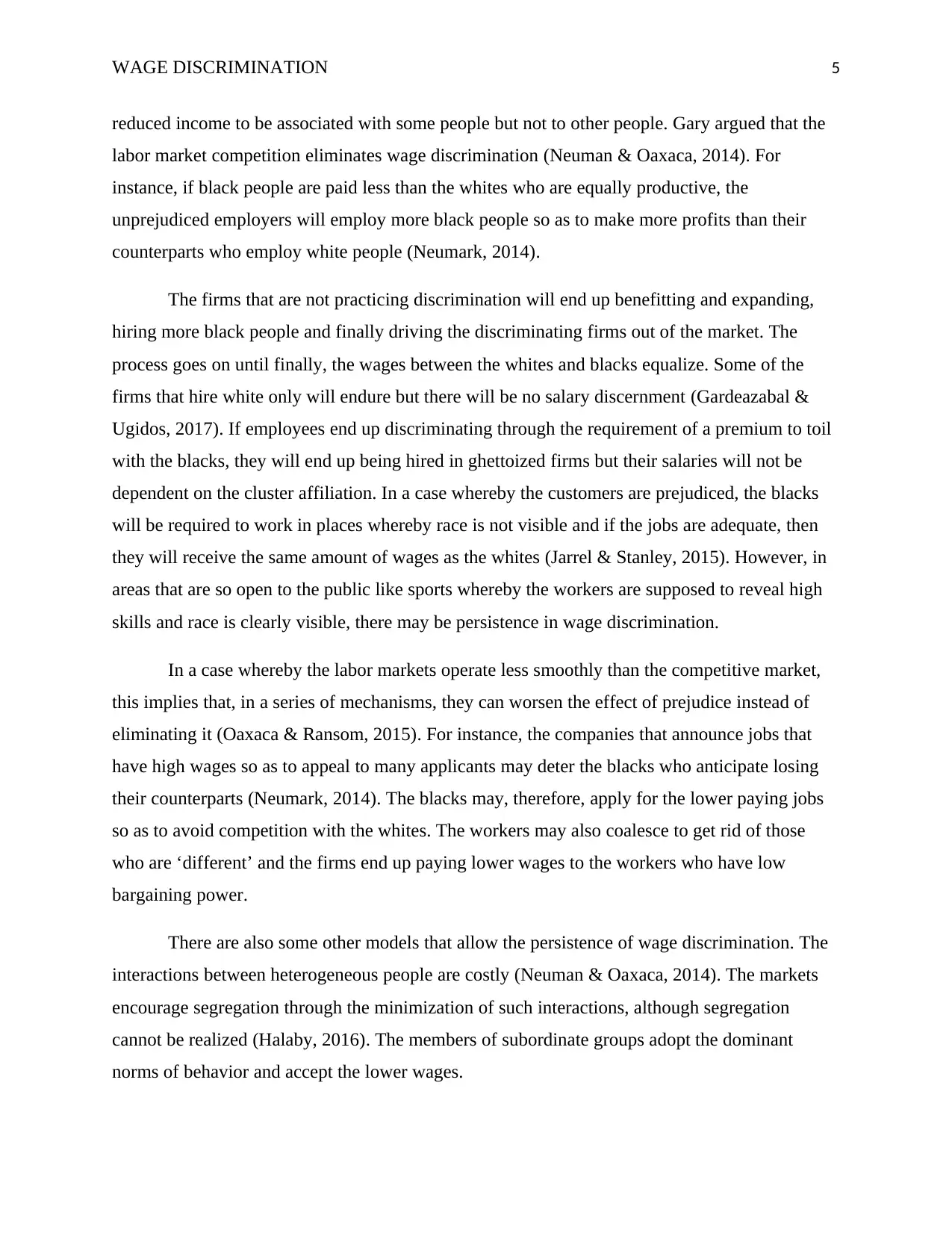
WAGE DISCRIMINATION 5
reduced income to be associated with some people but not to other people. Gary argued that the
labor market competition eliminates wage discrimination (Neuman & Oaxaca, 2014). For
instance, if black people are paid less than the whites who are equally productive, the
unprejudiced employers will employ more black people so as to make more profits than their
counterparts who employ white people (Neumark, 2014).
The firms that are not practicing discrimination will end up benefitting and expanding,
hiring more black people and finally driving the discriminating firms out of the market. The
process goes on until finally, the wages between the whites and blacks equalize. Some of the
firms that hire white only will endure but there will be no salary discernment (Gardeazabal &
Ugidos, 2017). If employees end up discriminating through the requirement of a premium to toil
with the blacks, they will end up being hired in ghettoized firms but their salaries will not be
dependent on the cluster affiliation. In a case whereby the customers are prejudiced, the blacks
will be required to work in places whereby race is not visible and if the jobs are adequate, then
they will receive the same amount of wages as the whites (Jarrel & Stanley, 2015). However, in
areas that are so open to the public like sports whereby the workers are supposed to reveal high
skills and race is clearly visible, there may be persistence in wage discrimination.
In a case whereby the labor markets operate less smoothly than the competitive market,
this implies that, in a series of mechanisms, they can worsen the effect of prejudice instead of
eliminating it (Oaxaca & Ransom, 2015). For instance, the companies that announce jobs that
have high wages so as to appeal to many applicants may deter the blacks who anticipate losing
their counterparts (Neumark, 2014). The blacks may, therefore, apply for the lower paying jobs
so as to avoid competition with the whites. The workers may also coalesce to get rid of those
who are ‘different’ and the firms end up paying lower wages to the workers who have low
bargaining power.
There are also some other models that allow the persistence of wage discrimination. The
interactions between heterogeneous people are costly (Neuman & Oaxaca, 2014). The markets
encourage segregation through the minimization of such interactions, although segregation
cannot be realized (Halaby, 2016). The members of subordinate groups adopt the dominant
norms of behavior and accept the lower wages.
reduced income to be associated with some people but not to other people. Gary argued that the
labor market competition eliminates wage discrimination (Neuman & Oaxaca, 2014). For
instance, if black people are paid less than the whites who are equally productive, the
unprejudiced employers will employ more black people so as to make more profits than their
counterparts who employ white people (Neumark, 2014).
The firms that are not practicing discrimination will end up benefitting and expanding,
hiring more black people and finally driving the discriminating firms out of the market. The
process goes on until finally, the wages between the whites and blacks equalize. Some of the
firms that hire white only will endure but there will be no salary discernment (Gardeazabal &
Ugidos, 2017). If employees end up discriminating through the requirement of a premium to toil
with the blacks, they will end up being hired in ghettoized firms but their salaries will not be
dependent on the cluster affiliation. In a case whereby the customers are prejudiced, the blacks
will be required to work in places whereby race is not visible and if the jobs are adequate, then
they will receive the same amount of wages as the whites (Jarrel & Stanley, 2015). However, in
areas that are so open to the public like sports whereby the workers are supposed to reveal high
skills and race is clearly visible, there may be persistence in wage discrimination.
In a case whereby the labor markets operate less smoothly than the competitive market,
this implies that, in a series of mechanisms, they can worsen the effect of prejudice instead of
eliminating it (Oaxaca & Ransom, 2015). For instance, the companies that announce jobs that
have high wages so as to appeal to many applicants may deter the blacks who anticipate losing
their counterparts (Neumark, 2014). The blacks may, therefore, apply for the lower paying jobs
so as to avoid competition with the whites. The workers may also coalesce to get rid of those
who are ‘different’ and the firms end up paying lower wages to the workers who have low
bargaining power.
There are also some other models that allow the persistence of wage discrimination. The
interactions between heterogeneous people are costly (Neuman & Oaxaca, 2014). The markets
encourage segregation through the minimization of such interactions, although segregation
cannot be realized (Halaby, 2016). The members of subordinate groups adopt the dominant
norms of behavior and accept the lower wages.
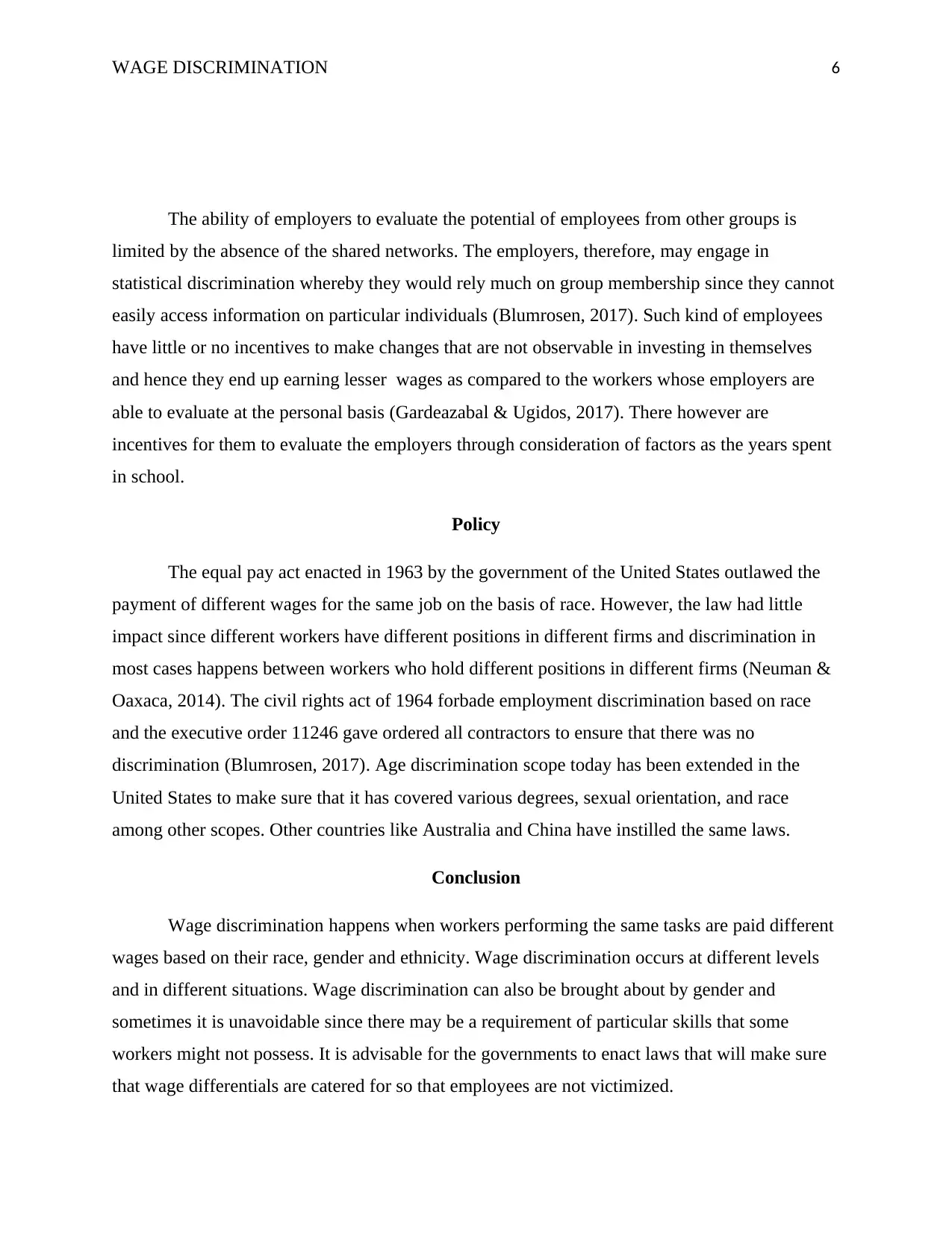
WAGE DISCRIMINATION 6
The ability of employers to evaluate the potential of employees from other groups is
limited by the absence of the shared networks. The employers, therefore, may engage in
statistical discrimination whereby they would rely much on group membership since they cannot
easily access information on particular individuals (Blumrosen, 2017). Such kind of employees
have little or no incentives to make changes that are not observable in investing in themselves
and hence they end up earning lesser wages as compared to the workers whose employers are
able to evaluate at the personal basis (Gardeazabal & Ugidos, 2017). There however are
incentives for them to evaluate the employers through consideration of factors as the years spent
in school.
Policy
The equal pay act enacted in 1963 by the government of the United States outlawed the
payment of different wages for the same job on the basis of race. However, the law had little
impact since different workers have different positions in different firms and discrimination in
most cases happens between workers who hold different positions in different firms (Neuman &
Oaxaca, 2014). The civil rights act of 1964 forbade employment discrimination based on race
and the executive order 11246 gave ordered all contractors to ensure that there was no
discrimination (Blumrosen, 2017). Age discrimination scope today has been extended in the
United States to make sure that it has covered various degrees, sexual orientation, and race
among other scopes. Other countries like Australia and China have instilled the same laws.
Conclusion
Wage discrimination happens when workers performing the same tasks are paid different
wages based on their race, gender and ethnicity. Wage discrimination occurs at different levels
and in different situations. Wage discrimination can also be brought about by gender and
sometimes it is unavoidable since there may be a requirement of particular skills that some
workers might not possess. It is advisable for the governments to enact laws that will make sure
that wage differentials are catered for so that employees are not victimized.
The ability of employers to evaluate the potential of employees from other groups is
limited by the absence of the shared networks. The employers, therefore, may engage in
statistical discrimination whereby they would rely much on group membership since they cannot
easily access information on particular individuals (Blumrosen, 2017). Such kind of employees
have little or no incentives to make changes that are not observable in investing in themselves
and hence they end up earning lesser wages as compared to the workers whose employers are
able to evaluate at the personal basis (Gardeazabal & Ugidos, 2017). There however are
incentives for them to evaluate the employers through consideration of factors as the years spent
in school.
Policy
The equal pay act enacted in 1963 by the government of the United States outlawed the
payment of different wages for the same job on the basis of race. However, the law had little
impact since different workers have different positions in different firms and discrimination in
most cases happens between workers who hold different positions in different firms (Neuman &
Oaxaca, 2014). The civil rights act of 1964 forbade employment discrimination based on race
and the executive order 11246 gave ordered all contractors to ensure that there was no
discrimination (Blumrosen, 2017). Age discrimination scope today has been extended in the
United States to make sure that it has covered various degrees, sexual orientation, and race
among other scopes. Other countries like Australia and China have instilled the same laws.
Conclusion
Wage discrimination happens when workers performing the same tasks are paid different
wages based on their race, gender and ethnicity. Wage discrimination occurs at different levels
and in different situations. Wage discrimination can also be brought about by gender and
sometimes it is unavoidable since there may be a requirement of particular skills that some
workers might not possess. It is advisable for the governments to enact laws that will make sure
that wage differentials are catered for so that employees are not victimized.
⊘ This is a preview!⊘
Do you want full access?
Subscribe today to unlock all pages.

Trusted by 1+ million students worldwide
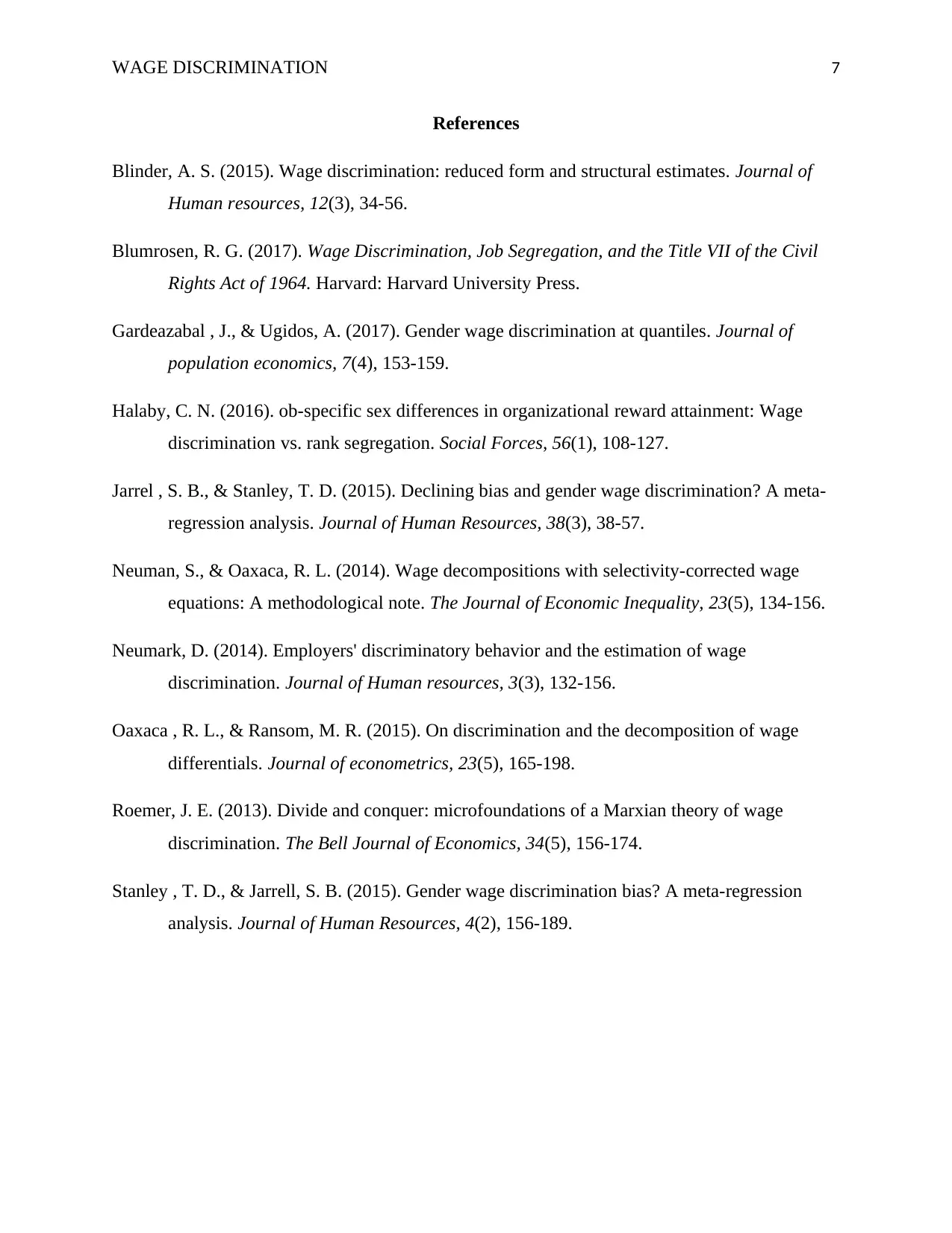
WAGE DISCRIMINATION 7
References
Blinder, A. S. (2015). Wage discrimination: reduced form and structural estimates. Journal of
Human resources, 12(3), 34-56.
Blumrosen, R. G. (2017). Wage Discrimination, Job Segregation, and the Title VII of the Civil
Rights Act of 1964. Harvard: Harvard University Press.
Gardeazabal , J., & Ugidos, A. (2017). Gender wage discrimination at quantiles. Journal of
population economics, 7(4), 153-159.
Halaby, C. N. (2016). ob-specific sex differences in organizational reward attainment: Wage
discrimination vs. rank segregation. Social Forces, 56(1), 108-127.
Jarrel , S. B., & Stanley, T. D. (2015). Declining bias and gender wage discrimination? A meta-
regression analysis. Journal of Human Resources, 38(3), 38-57.
Neuman, S., & Oaxaca, R. L. (2014). Wage decompositions with selectivity-corrected wage
equations: A methodological note. The Journal of Economic Inequality, 23(5), 134-156.
Neumark, D. (2014). Employers' discriminatory behavior and the estimation of wage
discrimination. Journal of Human resources, 3(3), 132-156.
Oaxaca , R. L., & Ransom, M. R. (2015). On discrimination and the decomposition of wage
differentials. Journal of econometrics, 23(5), 165-198.
Roemer, J. E. (2013). Divide and conquer: microfoundations of a Marxian theory of wage
discrimination. The Bell Journal of Economics, 34(5), 156-174.
Stanley , T. D., & Jarrell, S. B. (2015). Gender wage discrimination bias? A meta-regression
analysis. Journal of Human Resources, 4(2), 156-189.
References
Blinder, A. S. (2015). Wage discrimination: reduced form and structural estimates. Journal of
Human resources, 12(3), 34-56.
Blumrosen, R. G. (2017). Wage Discrimination, Job Segregation, and the Title VII of the Civil
Rights Act of 1964. Harvard: Harvard University Press.
Gardeazabal , J., & Ugidos, A. (2017). Gender wage discrimination at quantiles. Journal of
population economics, 7(4), 153-159.
Halaby, C. N. (2016). ob-specific sex differences in organizational reward attainment: Wage
discrimination vs. rank segregation. Social Forces, 56(1), 108-127.
Jarrel , S. B., & Stanley, T. D. (2015). Declining bias and gender wage discrimination? A meta-
regression analysis. Journal of Human Resources, 38(3), 38-57.
Neuman, S., & Oaxaca, R. L. (2014). Wage decompositions with selectivity-corrected wage
equations: A methodological note. The Journal of Economic Inequality, 23(5), 134-156.
Neumark, D. (2014). Employers' discriminatory behavior and the estimation of wage
discrimination. Journal of Human resources, 3(3), 132-156.
Oaxaca , R. L., & Ransom, M. R. (2015). On discrimination and the decomposition of wage
differentials. Journal of econometrics, 23(5), 165-198.
Roemer, J. E. (2013). Divide and conquer: microfoundations of a Marxian theory of wage
discrimination. The Bell Journal of Economics, 34(5), 156-174.
Stanley , T. D., & Jarrell, S. B. (2015). Gender wage discrimination bias? A meta-regression
analysis. Journal of Human Resources, 4(2), 156-189.
1 out of 7
Related Documents
Your All-in-One AI-Powered Toolkit for Academic Success.
+13062052269
info@desklib.com
Available 24*7 on WhatsApp / Email
![[object Object]](/_next/static/media/star-bottom.7253800d.svg)
Unlock your academic potential
Copyright © 2020–2025 A2Z Services. All Rights Reserved. Developed and managed by ZUCOL.





